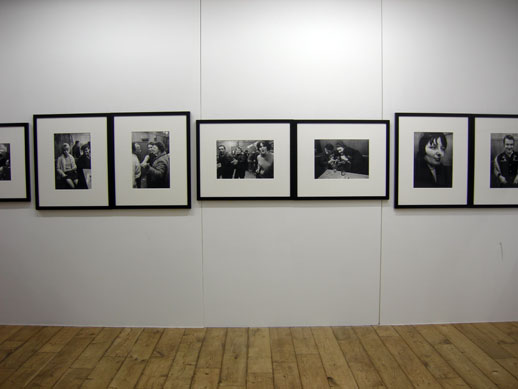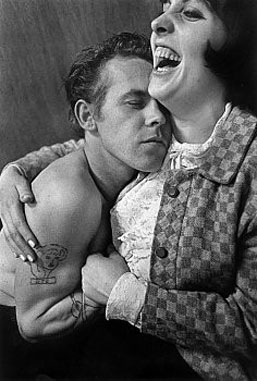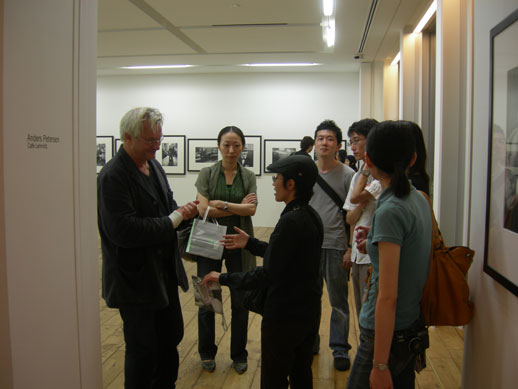Anders Petersen Welcomes You to the Café Lehmitz
In 1962, an 18-year-old backpacker, fleeing from his typical bourgeois upbringing in Sweden, and wanting to explore the world, found himself in the Reeperbahn, Hamburg’s notorious red-light district. It was certainly like nothing he had known at home. Buoyed by the sheer excitement of the place, he became one of the nighthawks and stuck around for a lack of anything better to do. He soon returned to Sweden, nursing a broken heart. He tried his hand at writing and painting, but found them too lonely, being essentially a social person. He decided to go into fashion photography, a good chance to meet a lot of girls. “It was a shallow decision,” Anders Petersen remarked years later. Then came an experience that gave new focus to his artistic efforts and changed the course of his life. He saw a photograph of a Paris cemetery at night, covered in a blanket of snow. There were no people present, but there were footprints in the snow. Even more inspiring than the photo itself was learning that it was produced by a fellow Swede, Christer Stromholm. The young Petersen sought out Stromhold, who today is considered the founding father of contemporary Swedish photography, and studied has his photo school in 1966.
In the meantime, Hamburg’s Reeperbahn had been introduced to the world in Gualtiero Jacopetti’s 1962 documentary Mondo Cane. It was not an especially pretty picture. Men and women with broken teeth and bruised faces, drinking, dancing, and smoking in the many beerhalls of Reeperbahn until the early morning, and then tumbling into the streets to fistfight, vomit, urinate, dance, or simply fall asleep while standing upright in the middle of the street. Around this time, an unknown band from England called the Beatles was playing long sets of rock and roll standards at the Star-Club and other nightspots in the rough-and-tumble neighborhood. After their sojourn in Hamburg, the lads would need quite a bit of scrubbing up before the launch of Beatlemania. John Lennon was later quoted as saying “I might have been born in Liverpool, but I grew up in Hamburg.”
Anders Petersen could very well say he was born in Solna, Sweden, but grew up in Hamburg, for it was here that he returned in 1967, after studying with Stromholm. He found himself gravitating toward the Reeperbahn again, only this time his camera gave him a purpose. Of the many drinking establishments in the area, he found his home away from home in the Café Lehmitz, a dingy beerhall open nearly 24 hours a day, serving stokers, off-hours prostitutes, pensioners, sailors, and whoever else happened to come in. While many of the patrons of the Lehmitz had been rejected by society, Petersen found them strangely welcoming and friendly. “The people at the Café Lehmitz had a presence and a sincerity that I myself lacked,” the photographer reminisced years later. “It was okay to be desperate, to be tender, to sit all alone or share the company of others. There was a great warmth and tolerance in this destitute setting.”

It is this range of human emotions that Petersen captured in the series of photographs he took in the three years he spent as a regular at the Lehmitz. One of the shots shows a barroom brimming with tension. The two men in the center of the frame are in the midst of either a very enthusiastic conversation or a fierce argument. Had they been wearing shirts, they would probably have each other by the collar. Instead, they stand shirtless, nearly nose-to-nose, each ready to attack the other. There are beer glasses everywhere, and it is easy to imagine one smashed over someone’s head in the next moment. The other patrons look on with passive curiosity. However, a closer look reveals that many of the bystanders are laughing—such a fight was obviously a common scene in the Café Lehmitz, and would soon blow over. To the viewer of the photograph, the pose of the men starts to look more ridiculous than violent.
Many of pictures are oddly touching. One, which serves as the poster for this exhibition, shows a relatively young man embracing a girl in a short skirt and a long coat. There is a strong backlight—perhaps the morning sunlight pouring through the always-open door of the café? The couple appears to be in the midst of a slow dance. There is a jukebox in the background, but judging from the look of this bar in the other photographs, it is easy to imagine that it doesn’t work. Are they dancing to a melody that they alone can hear? One of the most famous photos in the series shows shirtless young man snuggling up to the ample breast of a laughing woman. Despite the rather crudely drawn tattoos on his arm, he looks innocent and vulnerable, as the woman is powerful and protecting. When the viewer realizes that this is the same man who appeared in photograph of a fight in the making, and the woman is one who was laughing at the scene, the rawness of the emotion becomes even more apparent.

40 years have passed since Petersen first starting clicking his shutter in the Lehmitz, which is closed now, reportedly converted into a non-denominational church trying to save souls of the prostitutes who still work the area. However, his Café Lehmitz photographs are still very much relevant today. The collection is invaluable as a document of the zeitgeist of 1960s Germany, but more importantly, it set a new standard in photography for expressing the connection of the artist and the subject. “To me, it’s encounters that matter,” Petersen has been quoted as saying. “Pictures are much less important.”

That Petersen is “a people person” becomes apparent at the opening reception for his show at the Rat Hole Gallery in Aoyama. He mingles with the crowd, speaking now in English, now in German, and he becomes very excited when he meets a visitor who speaks a few words of Swedish. He speaks no Japanese, but that is in no way a hindrance. “No, not for art!” he says to a group of young Japanese admirers at the gallery, his enthusiasm making his message clear. “Not for art, but for yourself. Not for photography, for yourself.” Petersen mentions that he spent four hours before the gallery show photographing in crowded Shinjuku station. “It’s wonderful!” he exclaims. “People were just coming to me, women and men, young and old. A sea of people!”
Kevin Mcgue
Kevin Mcgue



